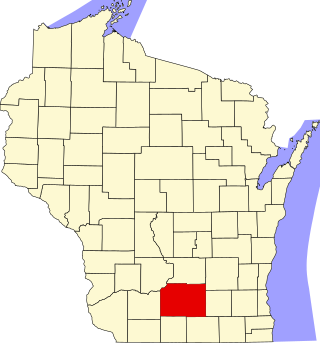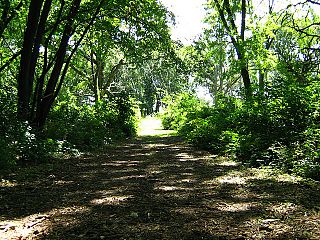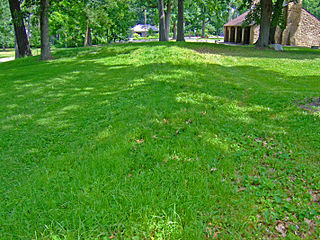
Effigy Mounds National Monument preserves more than 200 prehistoric mounds built by pre-Columbian Mound Builder cultures, mostly in the first millennium CE, during the later part of the Woodland period of pre-Columbian North America. Numerous effigy mounds are shaped like animals, including bears and birds.

Lizard Mound State Park is a state park in the Town of Farmington, Washington County, Wisconsin near the city of West Bend. Established in 1950, it was acquired by Washington County from the state of Wisconsin in 1986. It contains a significant well-preserved effigy mound group.

An effigy mound is a raised pile of earth built in the shape of a stylized animal, symbol, religious figure, human, or other figure. The Effigy Moundbuilder culture is primarily associated with the years 550-1200 CE during the Late Woodland Period, although radiocarbon dating has placed the origin of certain mounds as far back as 320 BCE.

This is a list of the National Register of Historic Places listings in Dane County, Wisconsin. It aims to provide a comprehensive listing of buildings, sites, structures, districts, and objects in Dane County, Wisconsin listed on the National Register of Historic Places.

Whitewater Effigy Mounds Preserve is a park operated by the city of Whitewater, Wisconsin. The 21.5-acre park is located on the west side of the city. It was added to the National Register of Historic Places in 1991.

The Beattie Park Mound Group is a grouping of Late Woodland period Indian mounds located in downtown Rockford, Illinois, United States.

The Alligator Effigy Mound is an effigy mound in Granville, Ohio, United States. The mound is believed to have been built between AD 800 and 1200 by people of the Fort Ancient culture. The mound was likely a ceremonial site, as it was not used for burials.

High Cliff State Park is a 1,187-acre (480 ha) Wisconsin state park near Sherwood, Wisconsin. It is the only state-owned recreation area located on Lake Winnebago. The park got its name from cliffs of the Niagara Escarpment, a land formation east of the shore of Lake Winnebago that stretches north through northeast Wisconsin, Upper Michigan, and Ontario to Niagara Falls and New York State.

Rock Eagle Effigy Mound is an archaeological site in Putnam County, Georgia, U.S. estimated to have been constructed c. 1000 BC to AD 1000. The earthwork was built up of thousands of pieces of quartzite laid in the mounded shape of a large bird. Although it is most often referred to as an eagle, scholars do not know exactly what type of bird the original builders intended to portray. It is listed on the National Register of Historic Places (NRHP) because of its significance. The University of Georgia administers the site. It uses much of the adjoining land for a 4-H camp, with cottages and other buildings, and day and residential environmental education.

This is a list of the National Register of Historic Places listings in Kenosha County, Wisconsin.
Mero Mound Group or Diamond Bluff Site is an archeological site near Diamond Bluff, Wisconsin, in Pierce County, Wisconsin. It consists of at least two village sites surrounded by hundreds of mounds, including three effigy mounds. All were constructed from around 1000 AD to 1300 AD.

Cranberry Creek Archeological District, also known as Cranberry Creek Mound Group, is an ancient American Indian burial mound site from circa AD 100–800 near New Miner, Wisconsin, United States. It is three miles east of Necedah National Wildlife Refuge in Juneau County. It is part of the "effigy mound culture" of native peoples in Wisconsin, who practiced the "respectful burial of their dead".

This is a list of the National Register of Historic Places listings in Jackson County, Wisconsin. It is intended to provide a comprehensive listing of entries in the National Register of Historic Places that are located in Jackson County, Wisconsin. The locations of National Register properties for which the latitude and longitude coordinates are included below may be seen in a map.

This is a list of the National Register of Historic Places listings in Madison, Wisconsin.

The Man Mound is a precontact earthwork of a humanoid figure located in Greenfield, Sauk County, Wisconsin, east of the city of Baraboo. Constructed during the Late Woodland period, the mound is the only surviving anthropomorphic effigy mound in North America. The mound depicts a humanoid figure with horns or a horned headdress and may have held religious or ceremonial significance to its builders. The mound was preserved as a county park in 1908, listed on the National Register of Historic Places in 1978 and designated a National Historic Landmark in 2016.

Burrows Park Effigy Mound and Campsite is an archaeological site in Burrows Park in Madison, Wisconsin. The site includes a bird-shaped effigy mound with an 128-foot (39 m) wingspan; it once included a fox-shaped mound as well, though it has been destroyed. The mound was built by Mound Builders during the Late Woodland period, likely between 700 and 1200 A.D. The Mound Builders used effigy mounds as burial sites, and bird-shaped mounds represented sky spirits in their religion; effigies of other animals were used to represent different elements. A 1934 restoration project repaired vandalism to the mound and cleaned up its surroundings.

The Elmside Park Mounds are a group of Native American mounds in Elmside Park in Madison, Wisconsin. The group includes two animal-shaped effigy mounds; while their shapes are inconclusive, they have been described as a lynx and a bear. The mounds were once part of the Oakridge Mound Group, which included three other mounds, but the others were destroyed by home construction. Mound Builder peoples built the mounds in the Late Woodland period, likely between 800 and 1100 A.D., to serve as burial and ceremonial sites. The mounds may be the only remnant of a Late Woodland community on the northeast shore of Lake Monona and are archaeologically significant in the study of Late Woodland civilizations.

The Mills Woods Mound, also known as the Hudson Park Mound, is a Native American mound in Hudson Park in Madison, Wisconsin. It is an animal-shaped effigy mound with a long tail, though the exact animal it represents is unclear. The mound was once part of the large Mills Woods Mound Group, which included roughly thirty mounds of various shapes, but construction destroyed every other mound in the group. The mound group was built during the Late Woodland period, roughly between 800 and 1100 A.D., by a Mound Builder group; the Mound Builders used mounds for burials and ceremonial purposes. The mound is one of less than 60 effigy mounds remaining in Dane County, which once had 289 of the mounds, and has potential archaeological significance for the study of Late Woodland civilizations.

The Observatory Hill Mound Group is a group of Native American mounds on Observatory Hill on the campus of the University of Wisconsin–Madison. The group consists of two effigy mounds, one in the shape of a bird and the other in the shape of a double-tailed turtle or water spirit. A panther effigy and a linear mound were once part of the group as well, but these were destroyed in the twentieth century. The mounds were built between 650 and 1200 A.D. by the Late Woodland people, who were responsible for building effigy mounds throughout Wisconsin.

The Blackhawk Country Club Mound Group is a group of Native American mounds on the grounds of Blackhawk Country Club in Madison, Wisconsin. The group includes an effigy mound shaped like a flying goose, three bear-shaped effigy mounds, a panther-shaped effigy, and an assortment of linear and conical mounds. The mounds were built by Late Woodland people between 650 and 1200 A.D.; these people were part of Wisconsin's Effigy Mound Culture, which was responsible for building the many mounds that can be found throughout the state. Country club member L. J. Markwardt convinced the club to preserve the mounds and restore a damaged section of the goose in the 1970s.




















